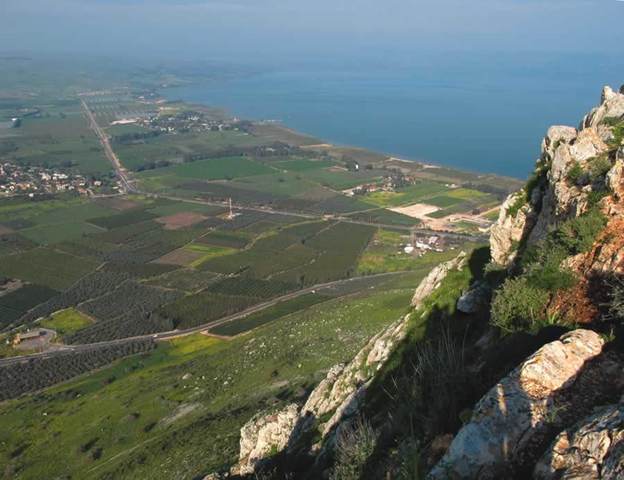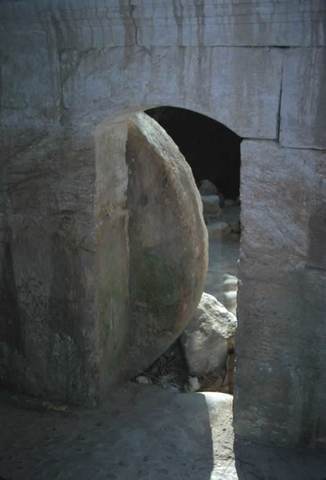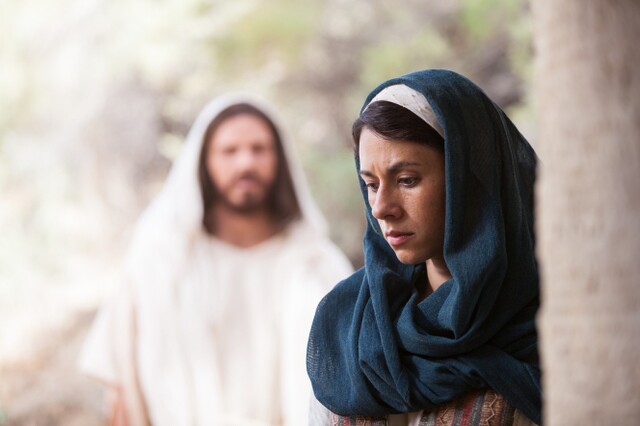Mary Magdalene is one of the best-known characters in the New Testament, yet we know surprisingly little about her. In all but one of the twelve times that she is mentioned in the four Gospels, she is either named alone or first in a list of women. The sole exception is in John’s account of the women who stood by the cross in which the mother of Jesus is listed first (John 19:25). Nevertheless, in the Gospel of John, Mary Magdalene is the premier witness of the Resurrection and the only one commissioned to tell others the stunning truth. The primacy of her name in these accounts, the frequency of her mention, and her role on the morning of the Resurrection suggest that she was a prominent and respected disciple in the first century. From the earliest interpretations of her, however, she has been assigned polar opposite roles: at one extreme, a repentant sinner who quietly served; at the other, the apostle to the apostles.
Mary’s Place of Residence
Mary was designated by her connection to her hometown rather than by her relationship to a parent or husband. She was Mary from Magdala, an identifier that suggests that she traveled and was therefore known in other geographical areas. Magdala is the Aramaic name for an impressive first-century city of some 1,000 to 1,500 inhabitants situated about four miles north of Tiberias on the western shore of the Sea of Galilee.1 Its Greek name, Taricheae, means “salted fish,” indicating the area’s fame for a salted-fish export industry located there.2
Mary's Daily Work
Because it was not unusual for lower-class women to acquire any one of a number of trades, Mary Magdalene may have been a fisherwoman and involved in the local trade, which could have given her access to the means to minister to Jesus in his travels.3 The Babylonian Talmud introduces another possibility for her trade. The name Magdalene could be interpreted to signify she was a hairdresser (bHag4b).
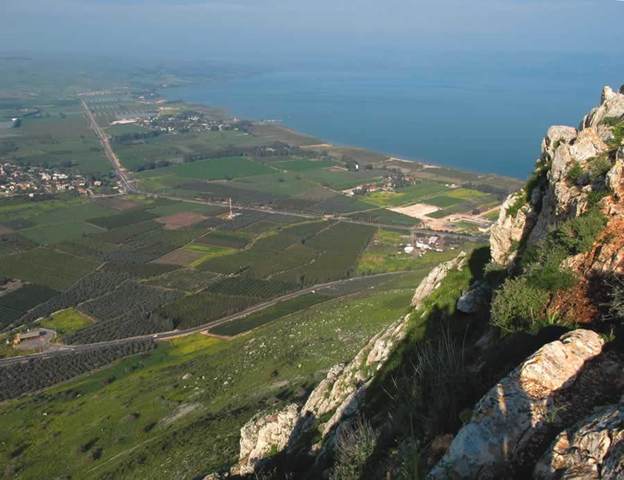
From atop Mount Arbel, looking down at Magdala, where Mary Magdalene lived. Image from Women of the New Testament.
Nothing in scripture reveals anything about Mary Magdalene’s family. She could have been married and perhaps involved in the family fishing business with her husband. Just as possible is that she was a widow or unmarried with skills to support herself. The details of her personal relationships were obviously not germane to the authors’ purpose. There is no evidence, however, that she was related to the family of Jesus or those of any of his apostles. Likewise, nowhere in scripture is she called a sinner.
Historical Context
In two of the Gospels, Mary Magdalene is reported to have been possessed by demons and healed by Jesus (Luke 8:2; Mark 16:9). Unbelievers may have embellished her previous condition to discredit her witness or her example, much as they did to Jesus when they accused him of being possessed by Beelzebub, the prince of demons (Mark 3:22).4
Only Luke and Mark mention that she had been possessed by “seven devils” (Luke 8:2; Mark 16:9), a detail that Luke, a physician, would have noticed. Jews generally did not understand what caused diseases and often considered serious illnesses as originating from the devil.5 Early Christian commentators linked Mary and the seven devils with the seven deadly sins,6 although nowhere else in the New Testament when Jesus healed someone possessed, such as the man with a legion of evil spirits (Luke 8:26–39), the two possessed of devils (Matt. 8:28–34), and the daughter of the Syrophoenician (Matt. 15:21–28), did he consider the possession a result of sin. Others have suggested that her strong spiritual sensitivities may have become unbalanced in the face of life’s challenges, leading her to be “dispossessed of herself.”7
The number seven in scripture often connotes wholeness, a complete period of time, or totality. Mary’s ailment involving seven devils may say more about the magnitude of Christ’s power to heal than her previous spiritual, emotional, or moral health. In announcing Mary’s cure, Luke may be confirming that through the power of Christ, Mary was completely healed, she was made whole, or she was completely liberated from her illness.8 In this sense, she is a prototype of all of us: enslaved by the pull of a fallen world, only Christ can free us.

From the Sea of Galilee, looking toward Magdala and Mount Arbel on the left. Image from Women of the New Testament.
After her healing, Mary Magdalene remained faithful to Jesus and free from the malady that previously plagued her. Her role in the Passion scenes underscores her subsequent faith, service, and leadership rather than any concerns in her former life.
Mary's Appearance in the New Testament Story
Witness of the crucifixion. The Gospels unanimously attest that Mary Magdalene was among the Galilean women who followed Jesus to Jerusalem and became active witnesses of his crucifixion.9 The male disciples scattered; the women of Galilee stood as sentinels and witnesses. The synoptic Gospels depict Mary as standing far enough away from the cross as if to communicate her censure of what was happening yet close enough to show her support for Jesus (Matt. 27:55–56; Mark 15:40; Luke 23:49). In John, Mary Magdalene stood with Mary, the Savior’s mother, close by the cross (John 19:25). Her stance in that Gospel reflects her commitment in the face of the shame associated with death on a cross.

The Church of Saint Mary Magdalene was built in Jerusalem in 1888 by Russian czar Alexander III to commemorate Mary Magdalene’s discipleship during the ministry of Jesus. It is a prominent landmark on the Mount of Olives, where it faces the Kidron Valley and walls of the Old City. Image from Women of the New Testament.
Because time did not allow for the customary sprinkling of spices and perfumed ointment on the strips of cloth used to wrap around the body before burial, the official burial ceremony could not occur until after the Sabbath.10 Mary and other women watched where the body was laid and returned home to rest for the Sabbath.
First to the empty tomb. The synoptic Gospels as well as traditions that predate their writing agree that Mary Magdalene and at least one other woman from Galilee were the first to discover the empty tomb early on that first Easter morning.11 Even though John identifies only Mary Magdalene at the scene (John 20:1), in her report to the apostles, she states, “We know not where” he is (John 20:2), implying that at least one other person accompanied her in making the initial discovery, as Matthew, Mark, and Luke report. Some New Testament scholars propose that John 20:2–10 was not part of the original text but was added later to conform more closely to the other accounts.12 By reading verse 11 after verse 1, John’s testimony suggests that the resurrected Christ appeared to Mary when she first discovered the empty tomb rather than upon her return after Peter and the other disciple verified that the tomb was empty.
Prepared to anoint the dead body of Jesus for whom she still mourned, Mary and perhaps other Galilean women were confused when they looked into the empty tomb. The pre-Resurrection world could explain the absence of the body only by a theory involving tomb robbing. When the two angels at the tomb told them that Jesus was not there but had risen and that they must tell the apostles what they had learned, Mary was eager to obey.
Matthew’s account is unique in its report of the resurrected Christ appearing to Mary Magdalene and the other Mary along the way as they returned to tell the male disciples their news. The two women fell at his feet, and he gave them the commission to tell the other disciples to meet him in Galilee (Matt. 28:9–10).
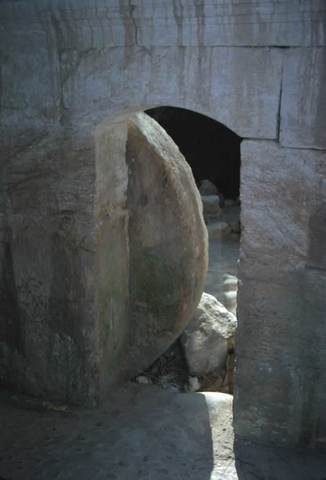
First-century tomb, viewed from the inside, in Midras, Israel. Image from Women of the New Testament.
The male disciples did not believe her. Mary may have been confused but she was not in doubt, even after the male disciples refused to believe her witness (Luke 24:10–11; John 20:3–8). According to John, Peter and another disciple ran to the tomb, witnessing that the burial clothes were folded, with those that covered the head separate from the burial strips that had clothed the rest of his body. The scene bespeaks a calm and orderly departure rather than a robbery. If indeed the resurrected Lord was the one who folded them, the neatly wrapped clothing suggests a solemn and reverent reflection, even awe, at what had just occurred. After the two apostles saw for themselves that Mary’s report was true, they “believed,” or were convinced, of Mary’s witness and quickly departed again, not yet understanding that “he must rise again from the dead” (John 20:4–10).
With Mary Magdalene alone at the tomb, John directs the reader to follow her quest and subsequent revelation. Undoubtedly other disciples could have testified of their own parallel experience of seeing the resurrected Christ, but it is Mary’s personal encounter with the resurrected Christ that is preserved. According to John, after everyone else had run away, Mary remained at the empty tomb, seemingly determined not to depart until she learned what had happened to the body of Jesus. She continued vigilant, ever loyal.
First to witness the resurrected Christ. Mary Magdalene did not recognize the Savior when he first appeared and spoke to her, calling her by the nonspecific term “Woman” (John 20:13). The generic term may invite each of us, whether man or woman, to put ourselves in her place to become a potential witness of truth. She did not at first recognize Jesus and assumed that he was the gardener. Perhaps her eyesight was blurred by tears, or perhaps Jesus’ physical appearance had been purposely changed to forestall recognition. The risen Lord may have wanted her to first know him through her spiritual eyes and ears rather than through her physical ones. In a similar way, disciples on the road to Emmaus could not recognize the resurrected Christ because “their eyes were holden” (Luke 24:16). Importantly, Mary neither comprehended the Savior’s Resurrection when she discovered the empty tomb nor when she actually saw him with her natural eyes.
When the Lord then said her name, “Mary,” her spiritual eyes were opened (John 20:16). Suddenly her encounter with the resurrected Lord had become very personal. In an example of what Jesus taught by way of metaphor in John 10, Mary heard the voice of the Good Shepherd when “he calleth his own sheep by name, and leadeth them out” (John 10:3).
“Touch me not.” Immediately upon her recognition of him, Mary Magdalene fell at his feet and addressed him as Rabboni (John 20:16). Although the term is properly translated “teacher” or “master,” it was often reserved for deity and therefore more honorific than “rabbi.”13 Her use of the term implies that she could see that Jesus had somehow changed.
Coinciding with her recognition was what appears to have been an instinctive attempt to touch him. The Lord’s response, “Touch me not,” is in the present imperative (John 20:17), which suggests a continuous action more precisely rendered, “Don’t keep touching me.”14 The term has been variously interpreted to mean “Stop holding me;”15 “Do not hold on to me;”16 “Don’t cling to me;”17 “Hold me not” (JST, John 20:17), or to discontinue whatever it was she was doing.18 Taken together, these several explanations combine to suggest that the Savior was asking Mary not to hold him back from what he still needed to do. Mary may have anticipated that Jesus had returned to remain with his followers forever and resume their association. In her anxious desire not to lose him again, she therefore wanted to cling to him to keep him there.
The Savior could not stay because he had not yet ascended to his Father. One final event in his great victory—returning to the presence of his Father—remained to be accomplished. Later that day, however, he would specifically invite others to touch him: “Handle me, and see; for a spirit hath not flesh and bones, as ye see me have” (Luke 24:39).
Between the Lines
Many have asked why Mary Magdalene received this remarkable experience. We could just as easily ask, Why not? We do not need a unique calling, title, or relationship with the Savior different from that of any other disciple to receive a spiritual witness. We need a broken heart, faith in him, and an opportunity for him to teach us. If for no other reason, she may have received this blessing simply because she lingered in a quiet spot rather than running off to talk with others. Church leaders have observed that we would have more spiritual experiences if we did not talk so much about them.19 Mary Magdalene teaches us to be still and learn that he is God (see Ps. 46:10; D&C 101:16).
The Savior’s singling out of women to be his witnesses cannot be anything but deliberate. His words and actions repeatedly reinforced his truth that women were not second class but worthy of the same blessings from God as men could receive. According to all four of the Gospel writers, the women were proven credible. Considering that the Gospels were written in the decades after the Resurrection of Jesus, it is arguable that Mary Magdalene became a prominent and respected member of the Christian community, although she is not mentioned in Luke’s Acts of the Apostles or in any of the apostles’ epistles.
Lead image from ChurchofJesusChrist.org
1. Reed, Archaeology and the Galilean Jesus, 82–83.
2. Anchor Bible Dictionary, s.v. “Magdala,” 4:463–64; Nun, “Ports of Galilee,” 27–29.
3. Schottroff, Lydia’s Impatient Sisters, 83–84; Corley, “Slaves, Servants and Prostitutes,” 200.
4. Corley, Women and the Historical Jesus, 34–35.
5. Ricci, Mary Magdalene, 133.
6. Haskins, Mary Magdalen, 14.
7. Ricci, Mary Magdalene, 138.
8. Bruce, Gospel of John, 126.
9. Fitzmyer, Gospel according to Luke, 1521.
10. Bruce, Gospel of John, 379.
11. See Matt. 28:1–6; Mark 16:1–6; and Luke 23:55–24:10. See also Brown, Gospel according to John, 2:977–78, 1001. Rather than suggesting that the women returned to anoint the body with fragrances, the apochryphal Gospel of Peter posits that their purpose was to appropriately “weep and lament” for the loss of a loved one, as “women are wont to do for those beloved of them who die” (vv. 50–52), in Schneemelcher, New Testament Apocrypha, 1:225.
12. Brock, Mary Magdalene, 57–59.
13. Haskins, Mary Magdalen, 9.
14. Huntsman, “Mary Magdalene,” 8.
15. Getty-Sullivan, Women in the New Testament, 189.
16. Ricci, Mary Magdalene, 143.
17. Swidler, Biblical Affirmations of Women, 204.
18. Brown, Gospel according to John, 2:992; Bruce, Gospel of John, 389–90.
19. Marion G. Romney, quoted by Maxwell, “Called to Serve,” 137.
In this well-researched and richly illustrated companion volume to Women of the Old Testament, author Camille Fronk Olson focuses on many of these remarkable women and explores the influence of Jesus Christ and his gospel on women living in the meridian of time.
It may be surprising to learn that their challenges and personal struggles are not unlike our own. From his beloved mother, to a quiet woman in a crowd, to two sisters each desiring to serve the Lord in her own unique way, to a woman weighed down by sin, they bore a powerful witness of the Savior before and during his earthly ministry. Others, including Lydia, Phebe, and Prisca, proclaimed truth and labored to spread the gospel after his Resurrection.
Amid traditions that frequently marginalized women or restricted them to certain roles, often defining them by their relationship to men, Jesus saw them first as individuals with agency to choose how they would use their God-given gifts.
